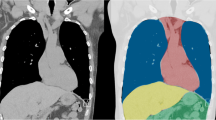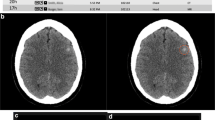Abstract
Advances in the field of artificial intelligence (AI), and in computing in the past decade, have made possible artificial neural networks that can “learn” to perform tasks previously reserved exclusively for humans. AI-enabled applications are already being deployed in radiology to assist in the detection and classification of diseases. The emergency department (ED), where timely and accurate diagnosis is critical, is an area of great interest for application of AI-driven solutions. AI algorithms offer great promise for addressing the challenges posed by increasing imaging volumes, increasing case complexity, and the need for rapid turnaround of results. Many products have already received US FDA clearance for clinical use. This chapter provides an introduction to key AI concepts, explores applications of AI in emergency radiology, and considers implications that AI will have for the field.
Access this chapter
Tax calculation will be finalised at checkout
Purchases are for personal use only
Similar content being viewed by others
References
Buchanan BG. A (very) brief history of artificial intelligence. AI Mag. 2005;26:53.
Chartrand G, Cheng PM, Vorontsov E, Drozdzal M, Turcotte S, Pal CJ, et al. Deep learning: a primer for radiologists. Radiographics. 2017;37(7):2113–31.
van Ginneken B. Fifty years of computer analysis in chest imaging: rule-based, machine learning, deep learning. Radiol Phys Technol. 2017;10:23–32.
Krizhevsky A, Sutskever I, Hinton GE. Imagenet classification with deep convolutional neural networks. Adv Neural Inf Process Syst. 2012;25:1097–105.
Do S, Song KD, Chung JW. Basics of deep learning: a radiologist’s guide to understanding published radiology articles on deep learning. Korean J Radiol. 2020;21:33–41.
Giger ML. Machine learning in medical imaging. J Am Coll Radiol. 2018;15(3):512–20.
Higaki T, Nakamura Y, Tatsugami F, Nakaura T, Awai K. Improvement of image quality at CT and MRI using deep learning. Jpn J Radiol. 2019;37(1):73–80.
Yasaka K, Abe O. Deep learning and artificial intelligence in radiology: current applications and future directions. PLoS Med. 2018;15(11):e1002707.
Baker JA, Rosen EL, Lo JY, Gimenez EI, Walsh R, Soo MS. Computer-aided detection (CAD) in screening mammography: sensitivity of commercial CAD systems for detecting architectural distortion. Am J Roentgenol. 2003;181(4):1083–8.
Fenton JJ, Abraham L, Taplin SH, Geller BM, Carney PA, D’Orsi C, et al. Effectiveness of computer-aided detection in community mammography practice. J Natl Cancer Inst. 2011;103(15):1152–61.
Gao Y, Geras KJ, Lewin AA, Moy L. New frontiers: an update on computer-aided diagnosis for breast imaging in the age of artificial intelligence. Am J Roentgenol. 2019;212(2):300–7.
FDA Cleared AI Algorithms | American College of Radiology [Internet]. [Cited 2020, Aug 10]. Available from: https://www.acrdsi.org/DSI-Services/FDA-Cleared-AI-Algorithms
Campbell BCV, Mitchell PJ, Kleinig TJ, Dewey HM, Churilov L, Yassi N, et al. Endovascular therapy for ischemic stroke with perfusion-imaging selection. N Engl J Med. 2015;372(11):1009–18.
Sorin V, Barash Y, Konen E, Klang E. Deep learning for natural language processing in radiology – fundamentals and a systematic review. J Am Coll Radiol. 2020;17(5):639–48.
Dikici E, Bigelow M, Prevedello LM, White RD, Erdal BS. Integrating AI into radiology workflow: levels of research, production, and feedback maturity. J Med Imaging. 2020;7(01):1.
Author information
Authors and Affiliations
Corresponding author
Editor information
Editors and Affiliations
Section Editor information
Rights and permissions
Copyright information
© 2022 Springer Nature Switzerland AG
About this entry
Cite this entry
Liu, J., Nazeri, A., Mintz, A. (2022). Role of Artificial Intelligence in Emergency Radiology. In: Patlas, M.N., Katz, D.S., Scaglione, M. (eds) Atlas of Emergency Imaging from Head-to-Toe. Springer, Cham. https://doi.org/10.1007/978-3-030-92111-8_2
Download citation
DOI: https://doi.org/10.1007/978-3-030-92111-8_2
Published:
Publisher Name: Springer, Cham
Print ISBN: 978-3-030-92110-1
Online ISBN: 978-3-030-92111-8
eBook Packages: MedicineReference Module Medicine




